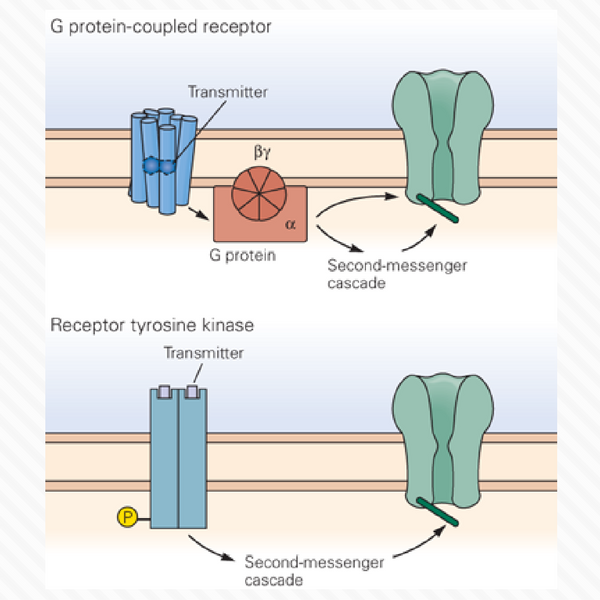In our previous article, I mentioned that after neurotransmitters are released into the synaptic cleft, they diffuse until they reach the postsynaptic membrane. There, they bind with either ionotropic or metabotropic receptors. Let me explain the difference between these two types of receptors.
Ionotropic receptors
Ionotropic receptors are transmembrane molecules that can “open” or “close” a channel that would allow smaller particles to travel in and out of the cell. As the name implies, IONotropic receptors allow different kinds of ions to travel in and out of the cell.

Ionotropic receptors are not opened (or closed) all the time. They are generally closed until another small molecule (called a ligand — In our case, a neurotransmitter) binds to the receptor.
As soon as the ligand binds to the receptor, the receptor changes conformation (the protein that makes up the channel changes shape), and as they do so they create a small opening that is big enough for ions to travel through.
Therefore, ionotropic receptors are “ligand-gated transmembrane ion channels”.
The ions that can travel through ionotropic receptors are generally limited to K+, Na+, Cl-, and Ca2+.
Metabotropic receptors
Metabotropic receptors do not have a “channel” that opens or closes. Instead, they are linked to another small chemical called a “G-protein.”

As soon as a ligand binds the metabotropic receptor, the receptor “activates” the G-Protein (it basically changes the G-Protein). Once activated, the G-protein itself goes on and activates another molecule. This new molecule is called a “secondary messenger.”
(A secondary messenger is a chemical whose function is to go and activate other particles).
So far, this process is common to all metabotropic receptors. What happens from there on is different for every metabotropic receptor.
- In some cases, the secondary messenger travel until it binds to and opens ion channels located somewhere else on the membrane.
- In some cases, the secondary messenger will go and activate other intermediate molecules inside the cell.
The important thing to remember is that metabotropic receptors do not have ion channels, and binding of a ligand may or may not result in the opening of ion channels at different sites on the membrane. But they will always activate a G-protein that will in turn activate secondary messengers.
As we mentioned in the previous article, glutamate receptors are metabotropic receptors.
Functional Differences: Ionotropic vs Metabotropic Receptors
Ionotropic receptors act very quickly. As soon as a ligand binds to them, they change shape and allow ions to flow in. But the ligand doesn’t stay in place very long, and the channel closes back very quickly.
Metabotropic receptors, on the other hand, take a little longer “to do anything” depending on the number of steps (secondary messengers), required to produce a response.
But once activated, the secondary messengers can travel throughout the cell and result in a much wider range of responses.
Conclusion
You at least only need to know the following to remember the differences between ionotropic and metabotropic receptors:
- Ionotropic and metabotropic receptors are both ligand-gated transmembrane proteins.
- Ionotropic receptors change shape when they are bound by a ligand. This change in shape creates a channel that allows ions to flow through.
- Metabotropic receptors do not have channels.
- Metabotropic receptors activate a G-protein that in turn activates a secondary messenger, that in turn will activate something else.
- Metabotropic receptor activation may or may not result in the opening of ion channels somewhere else on the membrane.
Infographic

If you want more articles and videos about the Nervous System, you can find them here. More resources are available to help make Biology fun. I invite you to absorb all the content you can find here at Interactive-Biology.com.

Receptors are generally present everywhere in the body right?
So since metabotropic receptors are slow but have kind of prolonged effect so can process digestion fits in the category or I mean consists of metabotropic receptors.
i’m sorry if my questions sounds lame I just want to clear my concepts.
And thankyou for writing a detailed article on these types of receptors.
HI Pluto,
What defines a metabotropic receptor is not the fact that it is slow and have prolonged effects.
What defines a metabotropic receptor is that it has a G-Protein attached to it, and that the G-Protein becomes activated when a ligand binds the receptor. This G-protein, in turn, will activate a secondary messenger.
It just so happens that metabotropic receptors also have slower and longer lasting effects.
I don’t know if process digestion requires metabotropic receptors (I’ve only studied the brain). But you could check is g-proteins and secondary messengers are involved 🙂
Thanks a Lottt !
“As we mentioned in the previous article, glutamate receptors are metabotropic receptors.”
I think they are ionotropic, not metabotropic.
Just to clarify…
Glutamate receptors can be both ionotropic or metabotropic.
Ionotropic glutamate receptors involve ligand-gated Ca ion channel opening via NMDA and AMPA receptors, whereas..
Metabotropic glutamate receptors couple G-protein and activate Phospholipase-C, which in turn activates IP3 or DAG.
Hope this helps!
Glorious. Why couldn’t my pharm professor in Vet school have explained it this way!?
This was super helpful! Easy to understand, hit on all the important info and not long-winded. Refreshing! Thank you!
kindly also provide authentic refreneces (from research articles/books). As this material z realy helpful bt after providng da refrencez
Extremely helpful and very eloquently explained. Thank you!
Amy is definitely right here…………
A+
Thanks for making my concept clear………. Great job
This was really helpful……thanks alot
This website is sooo helpful, thank you!
THANK YOU SO MUCH FOR THIS!!!! I’m in my first year of a rigorous Neuroscience PhD program, coming from a psychology background. This has helped me understand what I’ve spent hours freaking out over having not taken cell biology before. Thank you! 🙂
This was really helpful yet concise, I usually use Wikipedia to read about material I’m unfamiliar with, but this was better
Thank you so much,so detailed
Thank youu
Very useful article & easy to read.